The University of Maryland, College Park, is leading the way in studying the innovative applications of augmented and virtual reality across a wide range of fields
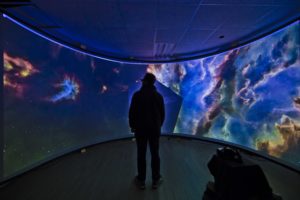
The potential applications of virtual and augmented reality in a host of disciplines–including education, science, medicine, the arts, entertainment and industry–are massive, say large institutions like the University of Maryland (UMD), whose Augmentarium serves as a potential instrumental model for innovative research facilities and universities looking to make their impact on the future.
On Wednesday, December 2, 2015, eCampus News was invited to take a tour of UMD’s Virtual and Augmented Reality Laboratory, also known as the Augmentarium, where I was given the opportunity to test out the University’s breakthroughs with the fledgling technology firsthand.
The Augmentarium was initially launched in December 2014 thanks to a 1 million dollar National Science Foundation (NSF) Major Research Instrumentation award, coupled with support from the College of Computer, Mathematical, and Natural Sciences and UMD administration.
Due to continual advances in graphics processing units allowing for a smaller size that consumes less and less power, as well as improved camera technologies, UMD says the time has finally arrived for quality virtual experiences to be delivered at a low cost.
Delivering on the promise of quality, the University of Maryland Institute for Advanced Computer Studies was named a center of excellence by NVIDIA, a world leader in designing and manufacturing graphics processing units for computer gaming and academia. The University says it has also been a leader in improving large-scale image processing technology for cameras since the 1960’s.
Now, the spearheading institution says it is primed to be a leader in testing the limits of virtual and augmented reality.
(Next page: The technology behind the Augmentarium; tangible benefits)
The main technology utilized by the Augmentarium is the highly popular Oculus Rift Development Kit 2, developed by CEO Brendan Iribe and chief software architect Michael Antonov, both former UMD students and current supporters of the University of Maryland Institute for Advanced Computer Studies.
Augmentarium director and leader of the event, Amitabh Varshney, a professor of computer science at the University, explained the differences between augmented reality and virtual reality, both of which are developed in the Augmentarium: Essentially, augmented reality superimposes and mixes virtual content with the world around us, embedding digital information into real-world settings via special visors, glasses or cameras. Virtual reality takes this concept a step further and fools the senses of sight and hearing (and perhaps one day even touch and smell) into thinking we are in a completely different real-world setting or even a world that would otherwise be impossible to represent.
After it became clear that imagination was seemingly the only limiter on what it is possible to create, attendees were treated to a host of examples revealing how many different areas of life could be improved through advances in augmented and virtual reality.
For example, augmented reality can play a large role in helping users unpack large amounts of information around them. On the consumer side of things, attendees were shown an example of being in a grocery store (and with lightweight, comfortable eyewear) and able to automatically identify what products, for example, do not have peanuts or gluten. Unique new experiences with the arts and video games should be expected as well.

In the world of public safety, attendees were shown how drones carrying cameras capable of taking gigapixel images could help law enforcement officials create a detailed augmented reality map of a sprawling national park to find a missing individual.
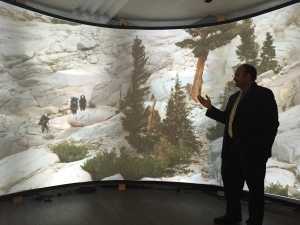
Safety can also be improved on college campuses or in any large space using virtual reality technology, as a safety official could get a better look at what’s going on around campus by being in a virtual live space thanks to the combination of a 3D model of a height map mixed with current video recordings (versus having to watch dozens of monitors that don’t give a good idea of space and timing).
Does Iron Man’s heads-up interface seem like fiction to you? Think again. Attendees were shown images of what a future solider or first responder could see through lightweight, durable visors attached to their headgear, which included constructive designations of their allies, potential IEDs, and even thermal outlines of potential enemies, all of which would simplify how to act and react in life or death situations.

(Next page: Augmentarium positions UMD as innovative business partner)
Dr. Sarah Murthi, a trauma surgeon at the R Adams Crowley Shock Trauma Center in Baltimore and a clinical associate professor at the University of Maryland School of Medicine, explained how the Augmentarium is also working closely with health care experts in order to design experiences that can help to train and improve the skills of doctors. Using lightweight headgear, surgeons could see critical information about their patient in real time while in the operating room, or even perform a surgery from a distance using virtual reality to see the patient and robotics to mimic their movements in the actual operating room. Doctors can also practice rare surgeries using virtual reality simulations to keep their skills sharp on their down time. Similarly, medical students can experience first-person training that they can repeat if they make a mistake to become more familiar and experienced with real-world situations.
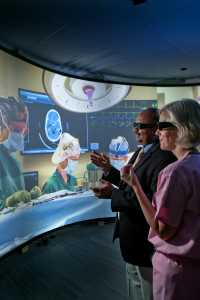
A UMD startup called VisiSonics, co-founded by Professor Ramani Duraiswami, was also highlighted, which the University says has greatly advanced the experience of 3-D audio so that everything sounds completely correct to the user, even to the slightest turn of his or her head. The technology has been licensed by Oculus Rift to be a key component of their upcoming commercial product in 2016.
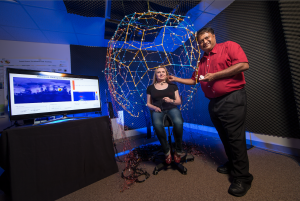
Finally, the potential uses of augmented and virtual reality within curricula could be limitless, since any concept with a special or physical component can be better understood through a student’s firsthand use of virtual reality technology, and would likely make learning even more interesting and exciting for most students, says the University. This increase in excitement has been seen at a successful UMD camp run by Jandelyn Plane, director of the Maryland Center for Women in Computing, in which underrepresented middle school girls learn about coding to design virtual games and experiences.
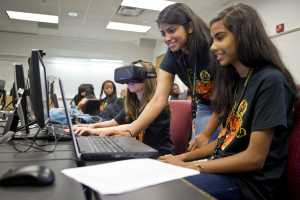
In fact, MOOCs could stand to benefit the most from advances in virtual technology, noted University reps; for instance, by enabling a student to enter a virtual classroom where they could interact with fellow participants.
Going Past Potential to Application
Attendees of the Augmentarium were able to see an algorithm identify high contrast areas of color, intensity and orientation in a 4.5 gigapixel image of Mt. Whitney to find a specific anomaly – a hiker in a red shirt – in mere moments. They were also shown images of what that person in the grocery store, or the soldier, or the surgeon would see using augmented reality glasses.
Beyond just augmented reality, attendees were able to enter into detailed virtual worlds as well.
For example, this editor was able to put on glasses and experience a shock trauma situation from the moment a helicopter landed through the beginning of a surgery–an experience that could prove invaluable for helping prepare students for feeling comfortable with similar situations when they actually become doctors.
I was also able to experience the advances VisiSonics have made with 3D sound technology as I progressed through a story where every bit of dialogue sounded authentic based on my distance from the speaker.
I was then invited to play a game designed by Plane’s middle school girls where I shot asteroids down in the vacuum of space, accurately targeted by my vision alone.
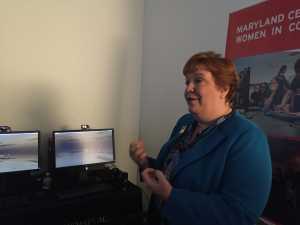
Finally, I flew through the caverns of a gigantic space station as if I were Luke Skywalker flying my X-Wing through the Death Star in Star Wars with such realism that my body did not initially allow me to take a step forward due to an instinctual attempt to avoid falling.
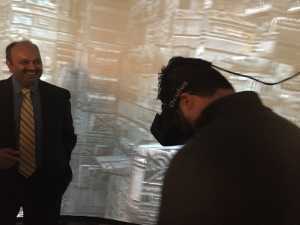
Sure, the Oculus Rift headgear might be large and bulky right now, but as Varshney wisely pointed out: remember cell phones 20 years ago?
With such a wide range of applications to explore for augmented and virtual reality, the projects the Augmentarium is working on are only the beginning. As more universities and companies begin to explore what AR and VR can do with the same dedication that the University of Maryland has shown thus far, the sky will truly be the limit.
Perhaps simply taking that step into a new world is all it will take.
- 4 reinvention best practices from across the pond - August 29, 2016
- New tool plays admissions matchmaker - August 15, 2016
- New tech to revolutionize studying abroad education - July 5, 2016

